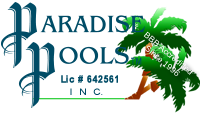How does proper water circulation help my pool?
WATER CIRCULATION
Properly adding chemicals to the pool water is just one step in the prevention of algae growth. Of equal importance is proper water circulation. Even if the chemical levels are well within ideal ranges where you take the test sample from, if the water is uncirculated, none of the chemicals will get evenly distributed throughout the pool water, thus there will be some areas of the pool with chemical levels far below ideal. Understanding how the water circulates throughout the pool, and what can be done to maximize the efficiency of the water's movement, is crucial in the prevention of algae growth. This section explains the swimming pool circulation system and it's operation.
A. SUCTION
There are two different "sides" of the pool's circulation system: the suction and the pressure sides. The suction side refers to the water that is approaching the pump from the pool, where as the pressure side refers to the water, which is returning to the pool after it has passed through the pump. The suction side of the system has two main components: the skimmer and the main drain. Water flows from the pool through each of these openings to the pump, and from there, proceeds through the filter and returns to the pool.
Skimmer And Main Drain
The skimmer is located immediately adjacent to the pool water inside the pool deck. There is a rectangular opening in the pool tile which leads into the skimmer and which contains the skimmer weir, a plastic door, hinged at the bottom, which prevents debris from re-entering the pool once the pump is turned off. Access to the skimmer is provided by a plastic cover on the pool deck, approximately 18 inches from the pool water, directly above the rectangular opening described above. Once the cover is removed, the skimmer basket is visible. The skimmer basket traps large debris such as bugs and leaves before it enters the pipes leading to the pump. Large debris such as this could become trapped in the pipes, causing restriction of water flow and possible starvation of the pump. Since the complete blockage of this basket could also lead to water flow restriction and improper circulation, it must be cleaned at least twice per week, and also immediately following a wind storm where large amounts of debris have been blown into the pool. Beneath the basket is a unit called a float valve (For pools equipped with a PCC-2000 automatic cleaning system, the float valve may not be present. In this event, please refer to the section of the manual on the PCC-2000 for more information). It is round and resembles a flying saucer. This float valve serves two functions. It regulates the flow between the main drain and the skimmer, and it also prevents air from entering the piping networks in the event that the pool water lever were to fall below the level of the skimmer entrance. On the bottom of the float valve there is a small teardrop-shaped flap attached to the valve with a single screw. This flap is responsible for the regulation of flow between the skimmer and the main drain. If the flap is closed, the main drain is the sale port through which the water flows out of the pool. If it is completely open, the skimmer transports most of the water out of the pool. Any position in between with result in a proportional amount of water flowing through the skimmer and the main drain. For example, if the flap were positioned so that it was about 3/4 closed, most of the water flowing out of the pool to the pump would flow through the main drain. On the other hand, if it were only 114 closed, the majority of the water flowing out of the pool would do so through the skimmer. For proper water circulation, it is best to position the flap so that it is about 2/3 closed. This will allow for more flow through the main drain than through the skimmer, which will promote a "bottom-to-top" circulation throughout the pool. Most of the water in the pool will be pulled through the main drain at the bottom of the pool and returned to the pool at the top, where the main returns are located (see the section of this manual on "Returns"). The float valve can be placed in the bottom of the skimmer in any orientation, as long as the flap is at the bottom. It should be noticed upon removal of the float valve that a black rubber a-ring is present in the bottom of the skimmer. This serves as a seal to ensure that all of the water flowing through the skimmer is flowing through the float valve, instead of around it. Inside the float valve is a small plastic float, which prevents air from passing through the skimmer in the event that the pool water level drops below that of the skimmer entrance. If this occurs, the float drops down and seals against another black 0- ring within the float valve assembly.
Beneath the float valve are two holes, each approximately 2 inches in diameter. The hole, which is closest to the swimming pool, is connected directly to the main drain at the bottom of the pool. The other hole is connected to the pump. While the pump is running, the hole farthest from the pool will be pulling water into it, and a strong suction should be felt, while no suction should be felt from the other hole. Once the float valve is in place and the flap is positioned correctly, the water will flow up through the pipe closer to the pool and will turn to flow down the pipe leading to the pump. If the float valve is not in place, the water will follow the path of least resistance and will only flow through the skimmer and into the pipe leading to the pump, and the main drain will not be functioning.
B. PRESSURE
The pressure side of the system refers to the water, which has already passed through the pump and is returning to the pool. The pressure side of the system includes the filter, backwashing assembly, heater (if present), the main returns, and the aerator. In this section, the main returns and the aerator are discussed leaving the filter, backwashing assembly, and the heater for subsequent sections.
Main Returns
The main water returns (named "returns" because the return water to the pool) are generally located about 1 foot beneath the water surface and resemble eyes in appearance. They may have openings ranging from 1/2 inch up to 1 inch. The outer ring of the return can be loosened by turning counter-clockwise in order to aim the orifice in a certain direction. Once the desired direction is achieved, the ring can then be tightened to hold the return in place. The returns should be aimed so that a circulation pattern exists on the surface of the pool. This usually means that all of the returns should be aimed either to the left or to the right, depending on the style of the particular pool. Usually, all of the returns should be aimed so that they are level with the water surface, as opposed to up or down. This may interfere with the operation of some suction-powered pool cleaners, however, and if this is the case, please refer to the section on "Suction-side pool cleaners".
Aerator
The aerator is a small fitting just above the water line approximately halfway along the poolside. The aerator serves a single purpose: to cool the water in the event that it gets too warm for either swimmer comfort of chemical efficiency. Above 900 F., chlorine becomes too active to remain in the water, and quickly dissipates. If the water temperature rises above 90° F, it is recommended to turn the aerator on by opening the valve, which controls it (see the labels on your specific pool valves to determine which is for the aerator). Water will flow from the aerator fitting and should spray approximately 2/3 of the way across the pool. If the spray does not carry this far, begin to close the valve, which flows to the main returns until the water flowing from the aerator reaches the desired spot. Be careful not to close the other valves completely, as a possible over- pressure situation may result, causing damage to the system or even personal injury. Watch the pressure gauge at the top of the filter to insure that the pressure does not rise above the maximum operating pressure of that particular filter.




